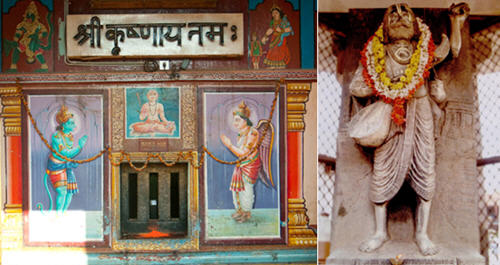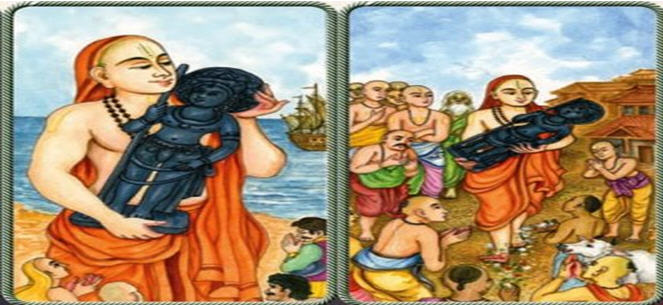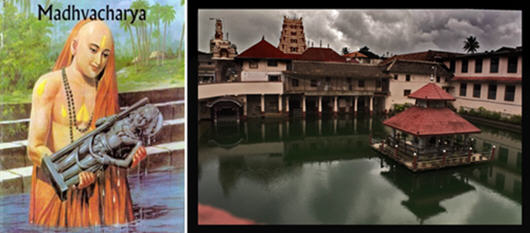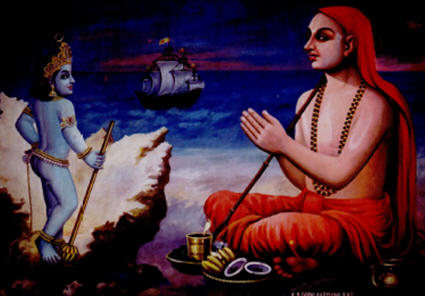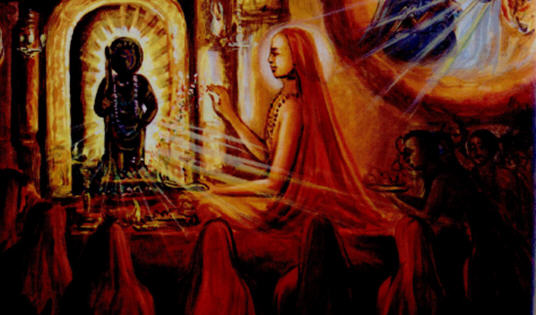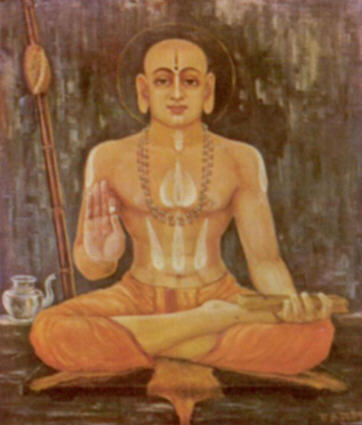
For twelve years Madhyageha Bhatta would regularly travel the eight miles north from his village of Belle to Udipi. There at the Ananteshvara temple he would pray for a son. One day a devotee in a trancelike state climbed the temple flagpole and announced that to reestablish the purest principles of religion, a male child, an incarnation of Vaayu, the demigod in charge in air, would soon be born. Madhyageha understood within his heart that this would be his own child. Soon his wife, Vedavati, gave birth to a son. The happy couple named him Vaasudeva.
From infancy Vaasudeva showed extraordinary intellect, so much so that he was given brahminical initiation at age five, three years early. Whatever he heard of read, even just once, he could remember. His body was unusually strong, lustrous, and beautiful. At age eleven, Vaasudeva left home for Udipi, to live with Acyutapreksha, an ascetic widely respected for his scholarship and saintly character. After one year, despite strong protest from his father, Vaasudeva renounced the world. Acyutapreksha named him Purnaprajna.
Less than forty days after taking sannyaasa, Purnaprajna defeated Vaasudeva Pandit, a famous wandering scholar, in a public debate. The Pandit was known for his hair-splitting dialectical ability, but he was no match for young Purnaprajna. The Pandit spoke for three days and then dared anyone to refute his conclusions. Purnaprajna shocked the crowd when he accepted the issues, he repeated almost verbatim the Pandit’s arguments. Then, one by one, he smashed them all. His victory was the talk of Udipi. Acyutapreksha gave him the title AAnandatirtha, in recognition of his mastery of Vedaanta.
Word spread far and wide about the debating skill of the young ascetic in Udipi. Challengers and admirers converged on the town. Buddhisaagara and Vaadisiàha, two Buddhist monks who had converted many to their fold, challenged Anandatirtha. After a day-long skirmish, they promised to return the next day. That night, however, they secretly fled from Udipi.
Anandatirtha went on a tour of South India. The most notable events on this tour were two encounters with Vidyaashankara Svaami, the lineal successor to Shripaada Shankaraacharya, who was the original propounder of the monistic theory of the Absolute Truth. Some basic tenets of Shankaraacharya’s philosophy are as follows: God and the soul are identical; the formless, senseless, impersonal Absolute is the only reality; all else is illusion; and the incarnations of God are all products of illusion. Anandatirtha was thoroughly familiar with this doctrine, so he knew all its weak points. With firmness and courage he challenged the venerated Vidyaashankara, and a fierce debate ensued. Vidyaashankara could not defeat his opponent, yet he refused to accept defeat. They met again, in Rameshvaram, during the monsoon season, at which time Vidyaashankara taunted and harassed Anandatirtha. But the young saint tolerated the abuse.
On his return journey, while addressing an assembly of learned men, Anandatirtha stated that every Vedic utterance conveyed a triple meaning, that each verse of the Mahaabhaarata had ten meanings, and that each of the thousand prominent names of Lord Vishnu had a hundred meanings. When the astonished assembly demanded he prove his statement, AAnandatirtha explained a hundred meanings of Vishva, the first name of Vishnu. Before he could proceed further, however, they begged him to stop, admitting they didn’t have the intelligence to comprehend his elaborate explanations.
Back in Udipi, Anandatirtha, who was now known as Madhva, wrote a commentary on the Bhagavad-gitaa and gave a copy to Acyutapreksha for his approval.
Madhva’s next tour was to Badarinaatha, high in the Himalayas. In Badarinaatha he met Shrila Vyaasadeva, the author of the four Vedas and their voluminous supplementary literature. In preparation for this meeting, Madhva had observed complete silence and complete fasting for forty-eight days. He learned the full meaning of the Vedaanta-sütra, the distilled essence of Vedic wisdom, from the transcendental author himself and promised to write a commentary on the sütras, one that would be faithful to Shrila Vyaasadeva’s original intent and purport. By the time he came down from the Himalayas, his commentary, Sütra-bhaashya, was completed. He sent a copy ahead to Udipi for Acyutapreksha’s approval.
On his return trip, Srila Madhvaacaarya converted Shobhana Bhatta and SaamiShaastri to Vaishnavism. They later became successors to Madhva, as Padmanaabha Tirtha and Narahari Tirtha. Madhva refused to let Narahari take sannyaasa, ordering him to remain in his high governmental position, in return for which he was to obtain the Deities of Müla Raama and Sitaa, lying in the King of Kalinga’s treasury. For many years Narahari remained in that service, until finally, just three months before Madhva’s departure from this world, Narahari brought the ancient images of Sitaa-Raama to his guru. These were the original Deities of Raama and Sitaa, worshiped by Mahaaraaja Ikshvaaku and then by Mahaaraaja Dasharatha, the father of Lord Raama. Then during the time of Lord Krishna’s advent, the Pandavas gave them to the Gajapati kings of Orissa. Eventually the Deities were kept in the king’s treasury.
While still in his twenties, Srila Madhvaacaarya undertook a second tour to Badarinaatha, this one after he had founded Shri Krishna Matha in Udipi. On the way, a tyrannical king pressed Madhva’s party into digging a reservoir for the city of Devagiri. Madhva, however, persuaded the king himself to take part in the digging and then left with the party. The pilgrims had many other hardships and misadventures, but Madhva always saved them with his quick thinking and mystic powers. In Badarinaatha, Madhva again heard from Vyaasa, who gave him eight sacred Shaalagraama stones.
On his return trip Madhva stopped in Goa, where he enacted an amazing gastronomical feat. Previously he had eaten a thousand bananas in one sitting. But in Goa, he outdid his earlier record. He ate four thousand bananas and then drank thirty pots of milk. When asked to prove that plants indeed respond to music, Madhva took a few seeds in his palm and began singing in his melodious voice. The seeds sprouted. Madhva continued singing, and the plants grew, swaying to the melody. Madhva continued singing. The plants grew into full maturity and yielded the fruits and flowers. News of this feat spread everywhere.
From Udipi Madhva traveled south again. In Vishnumangalam he debated with Trivikramaacaarya, a logician and grammarian of remarkable skill, who was able to make the Sanskrit language convey any meaning that suited his purpose. The debate lasted fifteen days, and in the end Trivikrama surrendered at Madhva’s feet. A full account of that debate is given in the Madhva-vijaya, written by the son of Trivikramaacaarya. News of Trivikrama’s conversion brought hundreds more men and women into Madhva’s fold. His life’s mission thus became firmly rooted in India.
SHrila Madhvaacaarya wrote thirty-nine books clarifying the tenets of Vaishnavism and showing Vaishnavism to be the true Vedic religion. In many of his works he attacked the monistic creed of Shankaraacaarya’s followers, exposing to impede Madhva’s mission by less honorable means. They tried to defame him, declaring him a heretic and all his followers outcasts. They even stole his writings and his valuable collection of ancient books, thinking that without literature his mission would be finished. Somehow, King Jaya Simha of Vishnumangalam acquired the books and returned them to Madhvaacaarya.
Madhva had appeared in two other incarnations. During the time of Lord Krishna’s appearance on earth he appeared as the warrior Bhima, one of the five Paandava brothers. During the time of Lord Raama, he incarnated as the beloved Hanumaan, the ideal servant of the Supreme Lord. And, as in those incarnations, Madhva performed many feats of strength and displayed mystical perfections. As a child he would appear suddenly in one mighty leap from anywhere in mighty leap from anywhere in response to his mother’s call. In school he cured a friend’s headache by blowing in his ear. To help his father out of debt he turned tamarind seeds into money. On two occasions he made seeds sprout into plants by his singing. An enormous rock in Ambu Tirtha, requiring at least fifty men to move it, bears an inscription stating that Madhvaacaarya placed it there with one hand. Many times Madhva made small quantities of food increase for distribution to hundreds of people. At the age of seventy-nine, his mission well established, SHrila Madhvaacaarya passed away. His devotees say he went to Badarinaatha to join Shrila Vyaasadeva.
